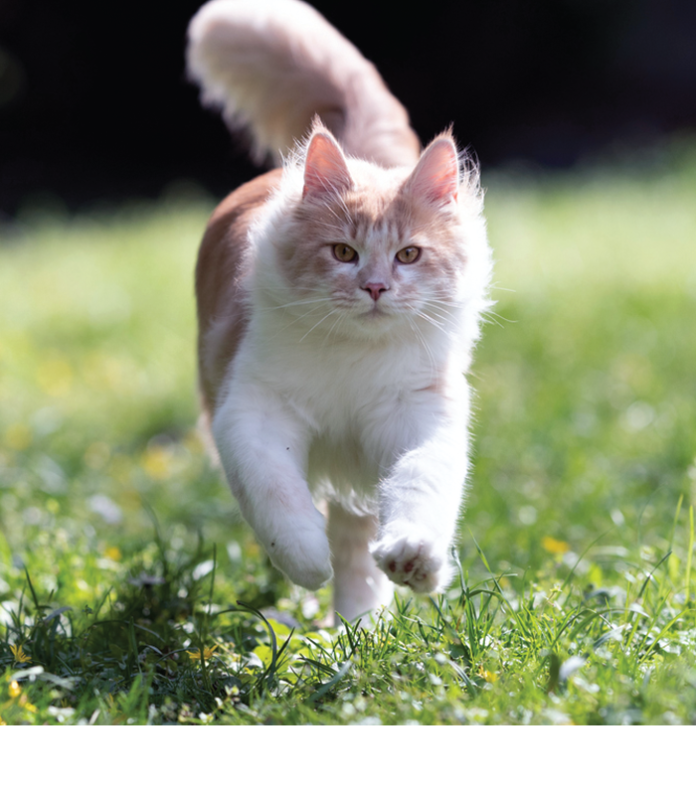Mycobacteria are a class of bacterial pathogens that can be difficult to treat, causing chronic conditions. In people, these bacteria cause illnesses like leprosy and tuberculosis. Fortunately, feline mycobacterial infections are rare.
Many cats that develop mycobacterial infections are immunocompromised, usually due to a chronic health condition or viral infection with feline leukemia virus or feline immunodeficiency virus, although infection in healthy, immunocompetent cats is possible. Siamese and Abyssinian cats are believed to have a genetic predisposition to M. avium bacterial infections (see sidebar).
The most common clinical signs of mycobacterial infections in cats are granulomatous skin nodules, non-healing sores and ulcers, and enlarged lymph nodes. If the disease spreads beyond the skin wounds, fever, difficulty breathing, multiple enlarged lymph nodes, and sometimes even lameness associated with bone pain may be noted.
Diagnosis
Most infections are diagnosed by cytology or histopathology (microscopic examination) of the skin lesions. A positive finding on acid fast staining is indicative of a mycobacterial infection. Culture in the laboratory is difficult. Polymerase chain reaction (PCR) studies can narrow down the exact species of bacteria involved.
Treatment
Treatment, if elected, requires long-term antibiotic administration, and multiple antibiotics may be necessary. The prognosis for cure is generally guarded to poor, and usually poor if a cat is immunosuppressed. These bacteria can often survive in macrophages, which is partially why they are difficult to eliminate. Rifampicin is often the anchor drug. Doxycycline and clarithromycin also may be given. Ideally, pharmacological therapy is combined with surgical removal of any lesions. Antibiotics should be given for at least two months past resolution of clinical signs. Some cats may require medication for as long as 12 months. Recurrent lesions may be surgically removed in some cases, with wide margins if possible.
Pilling a recalcitrant cat for months is not a positive experience, and some owners have opted for an esophagostomy tube for ease of medication. Gel capsules versus pills can be easier to administer.
Any cat with non-healing or recurrent skin ulcers, especially if that cat has access to the outdoors, should be considered a potential case of myocobacterial infection. Immunocompromised cats are likely at increased risk (and shouldn’t be going outside anyway!). It is important to have any lesions of this type looked at by your veterinarian, especially if you have immunocompromised people in your household, as while not highly likely, transmission of mycobacterial infections from cats to people is possible.
Feline Mycobacteria Infections
Three classes of feline health problems are caused by these bacteria:
The “Tuberculosis (TB) complex.” This includes M. tuberculosis, which is rare in cats, and M. bovis, which is more common. Cats living in endemic areas may pick up the infection if they are allowed outdoors.
In North America, eating raw deer, raw elk, raw bison, and unpasteurized (raw) milk are risk factors. Because there is an active testing program for dairy herds, the risk associated with drinking cow’s milk is considered low. Feral swine may be responsible for an uptick in mycobacterial infections of this class.
- microti causes tuberculosis in voles and cats. Cats seem to be naturally resistant to tuberculosis, however, there have been cases documented of infected humans passing this pathogen to cats. Male cats are more susceptible, and these infections are most often diagnosed in adult cats.
- lepramurium and M. visibilis. Small rodents can carry this bacteria, so an outdoor cat that hunts is at risk. A form of feline leprosy caused by M. visibilis has been identified in cats in Idaho and Oregon. These cats have a diffuse skin condition, with ulcers primarily on the head (including in the mouth and on the tongue) and limbs. Systemic spread may be seen, and these bacterial infections are often aggressive and may recur locally.
The non-tuberculosis (NTM) group. The most common class of feline mycobacterial infections comes from the NTM group, which are present in the environment. These are saprophytic organisms, which means they need dead or decaying organic matter to survive. M. avium is the most common culprit. These bacteria have the most potential for zoonotic spread, though almost always to immunocompromised people. Cats can become infected with these bacteria through wound contamination.
Zoonotic Infections
Feline mycobacteria infections are zoonotic (passing from people to animals and vice versa), although cats are not believed to be highly contagious to people. Cats are likely a “spillover” host, and the risk of transmission from cats to humans is highest with people that are immunocompromised. In a spillover host, the pathogen of concern has overcome the many naturally occurring barriers necessary to “spill over” from one species to another.




